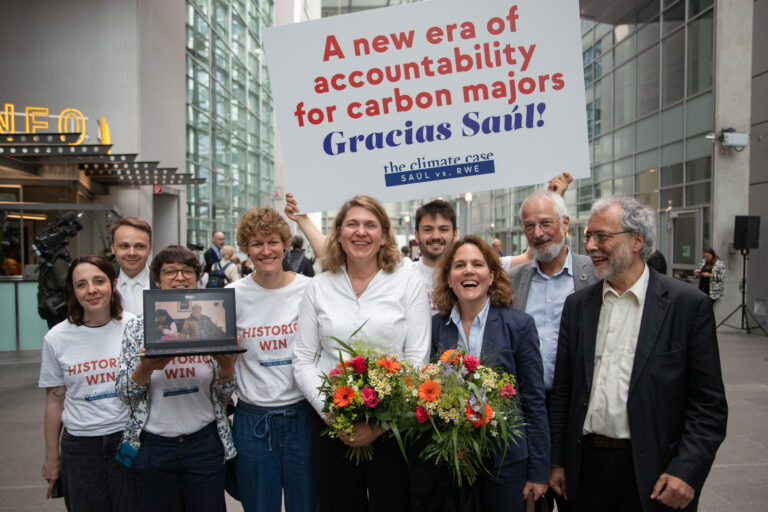Luciano Lliuya v. RWE: a major step forward for climate justice

The verdict released on 28 May by the Higher Regional Court of Hamm on the Luciano Lliuya v. RWE case established a powerful legal precedent that can be replicated in courts worldwide and will shape the trajectory for future climate litigation: corporate greenhouse gas emitters can, in principle, be held liable for their contribution to climate change impacts. Noah Walker-Crawford, Joy Reyes and Nicholas Petkov explain.
The verdict in the Luciano Lliuya v. RWE case – first brought by Peruvian farmer Saúl Luciano Lliuya against German energy company RWE 10 years ago – confirms that major greenhouse gas emitters can be held directly liable for the impacts of their emissions anywhere on the globe. While the Higher Court ultimately dismissed the individual claim, finding that the specific flood risk to Luciano Lliuya did not meet the legal threshold, it found that corporate liability for climate-related harm is possible in principle. It therefore gives vulnerable individuals and communities a chance to hold polluters responsible. This marks a vital turning point for climate litigation, offering a glimmer of hope for those who have long suffered from the consequences of corporate emissions but have lacked the legal recourse to demand accountability.
The case in brief
The case was filed in 2015 by Saúl Luciano Lliuya, a small-scale farmer and mountain guide from the Peruvian Andes, against RWE, a leading German utility company with a long history of coal-fired energy production. The claimant faces a risk from flooding caused by glacial retreat associated with rising temperatures. He demanded that RWE pay a share of costs for protective measures proportional to the company’s historical emissions.
The case was groundbreaking in addressing the global justice dimensions of climate change: many of those who face the worst impacts have made little contribution to emissions while major corporate polluters have not accepted responsibility for climate-related harm. Luciano Lliuya’s argument was rooted in attribution science, which links specific corporate emissions to tangible climate impacts, such as the melting glaciers that threaten his community. By pushing for RWE to take financial responsibility for the protective measures in Huaraz, Peru, Luciano Lliuya sought to hold the company accountable for its historical role in exacerbating global climate change.
A new era of accountability: eight takeaways
The verdict of the Regional Court of Hamm was lauded by environmental groups and activists because the court issued significant pronouncements that can be used in future climate litigation, demonstrating that the law is an appropriate tool for addressing corporate climate responsibility. Here are our eight key takeaways from the verdict:
1. Major emitters can be held liable for their contribution to climate-related harm
The judgment established the principle of corporate climate liability. The court found that major emitters have made a direct contribution to climate-related harm which infringes on the property rights of those affected. Partial contributions to global emissions can form the basis of liability if it is found that the risk to the claimant is sufficiently imminent and concrete. To remedy this, major emitters have the legal duty to remove these forms of harm in proportion to their contribution.
2. Attribution science demonstrates a direct link between major emitters and climate-related harm
In groundbreaking fashion, the court acknowledged that scientific evidence can establish a causal chain between a company’s emissions and the increased risk of harm, and attribution science can be used to establish this causal chain. The processes of climate change are scientifically well understood, and litigants can use attribution research to trace a direct connection between major emitters and climate-related harm.
3. ‘Carbon Majors’ (large-scale emitters) can no longer deny historical responsibility for climate change
The court said that an energy company such as RWE should have known that its emissions contributed to global warming since at least the mid-1960s, if not as early as 1958, when the Keeling Curve Study was released. The court found that the risks of climate change have been publicly known since that time, and major companies must stay informed about potential harm caused by their activities. In many corporate liability cases, emitters use the lack of historical knowledge about climate change in their counterarguments – the court has effectively debunked such claims.
4. Individual Carbon Majors can no longer rely on being ‘one of many’ emitters
RWE said that its contribution to climate change was miniscule, despite it being a major contributor to global greenhouse gas emissions. In its judgment, the court found that where there are multiple contributors to risk of harm, a claim is possible against each one of them. The claimant, Saul Luciano Lliuya in this case, can claim solely against one of them, in this case RWE. RWE’s argument that its emissions were insignificant and simply a ‘drop in the ocean’ did not hold water, as the court recognised that the company’s share of global emissions (at approximately 0.38%) was high enough in relation to others to allow for legal liability.
5. Corporations can no longer hide behind subsidiaries to avoid their responsibility for the climate crisis
RWE argued that the harm alleged by Luciano Lliuya resulted from its subsidiaries’ actions, as its coal-fired power plants were operated by other companies that it owned. The court ruled that the emissions of a company’s subsidiaries can be attributed to the parent company. This is crucial as it showed that fossil fuel emitters can no longer use such arguments to shift blame onto distant subsidiaries, contractors or supply chain partners to evade accountability.
6. The need for a stable energy supply does not justify burning fossil fuels
While energy security is important, in Germany as in other countries, and the provision of adequate energy supply is fundamental to Germany’s citizens and inhabitants, the court said that fossil fuels are not needed to achieve this demand. This is a powerful statement supporting the transition away from fossil fuels and towards renewables.
7. Geographical distance is no get-out clause – companies can be held liable for transboundary harm, including climate change
Despite being continents apart, RWE’s emissions could constitute a direct disturbance to Luciano Lliuya’s property in Huaraz. Under German civil law, the court found that the distance between the emitter and affected claimant is irrelevant and close proximity is not a prerequisite. This provides a green light for future litigation related to transboundary harm, particularly when it comes to climate change impacts.
8. Climate litigation is a legitimate avenue for seeking corporate accountability
The court affirmed that climate litigation is a legitimate tool to hold corporations accountable for their role in the climate crisis. This verdict marks a monumental shift: it opens the floodgates for those affected by climate-related harm to seek redress from major emitters. When the claim was filed in 2015, it was one of the first of its kind. Ten years on, dozens of cases have followed in its footsteps, and many more are likely in the future.
For further analysis of this case and many others, read the Institute’s latest ‘Global Trends in Climate Change Litigation’ snapshot report by Joana Setzer and Catherine Higham (June 2025).

